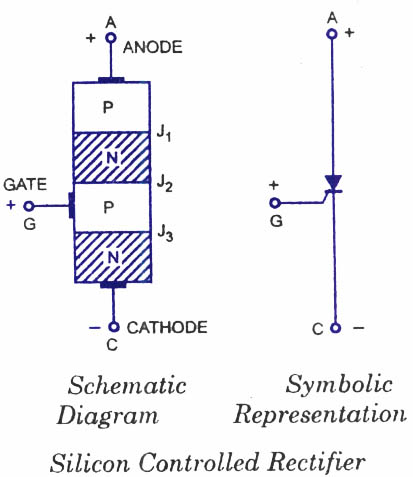SCR otherwise known as silicon controlled rectifier, it consist of four semiconductor layers forming a PNPN structure. It has three PN junction namely j1, j2 and j3. There are three terminal called anode (A), cathode (K) and Gate (G). SCR is forward bias with a small voltage, it is off and current flowing through the SCR will be zero. The applied forward voltage is increased, a certain critical voltage called forward break over voltage. At this causes the SCR switched ON position. If the SCR is reverse bias the junction j1 and j3 are reverse bias and junction j2 is forward bias.
The characteristic of the SCR is the relationship between the anode-cathode voltage and anode current at different gate current. There are two types of V-I characteristics. The first one is forward characteristic and the second one is reverse characteristics. The forward characteristics may be obtained by using adjustable DC supplies. It is the current drawn between the anode-cathode voltage and anode current at different gate current. The reverse characteristic may be obtained by reversing the connection of both the DC supplies. The SCR can be turn on from off position by many methods. Gate triggering is one of its. In this method the SCR is operated with an anode voltage slightly less than the rated forward break over voltage and triggered into conduction by a low gate pulse. It may be noted that once the SCR is switched on the gate has no further control on the device current. The second method is forward break over voltage; if the voltage across the SCR becomes greater than the forward break over voltage, the SCR is made to conduct due to avalanche breakdown. The third one is light triggering. In this method the SCR is triggered by illuminating it with light. When the light falls on the middle junction of the SCR the device turns on. Such a device is called Light activated Silicon Controlled Rectifier (LASCR). The fourth method is rate effect method. In this method the SCR is turned on by rapidly increasing the anode to cathode voltage. This produces a charming current, which triggers the SCR to conduction.
Applications of SCR
- It is a power control device
- Relay control
- As over light detector
- Statics switches
- Motor control
- Battery charges
- Heater control
- Phase controls
SCR controls large current in the load by means of a small gate current is one of its main disadvantages. And the size of the SCR is very compact and the switching speed is high.








